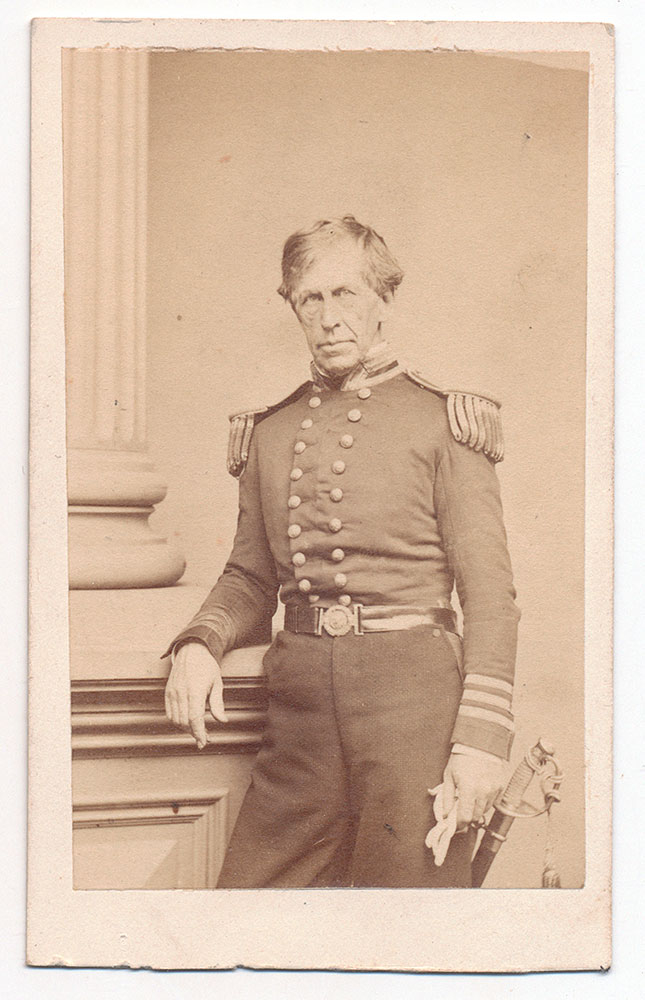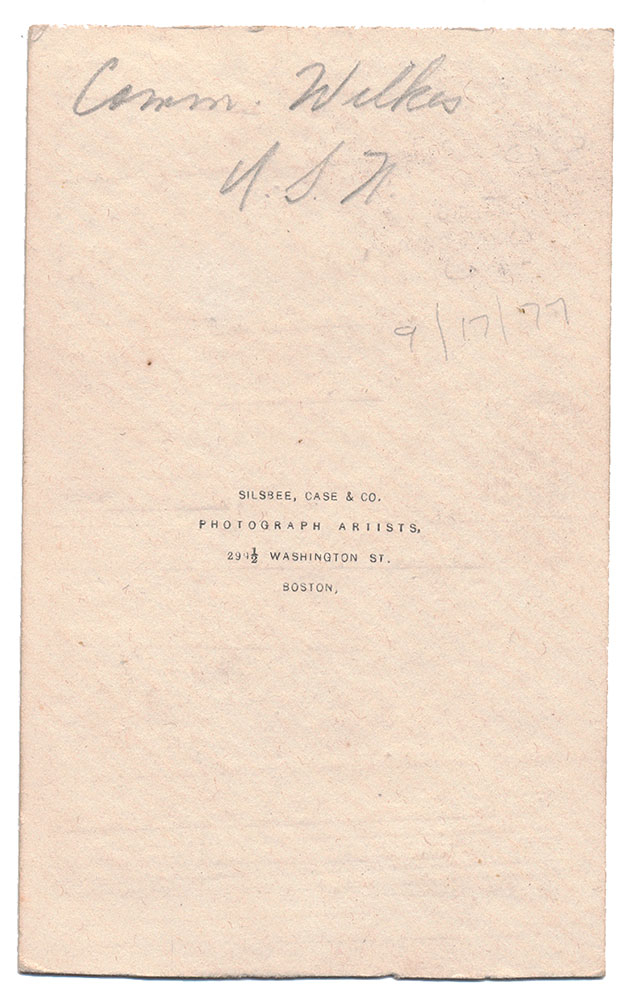site search
online catalog
THREE-QUARTER STANDING VIEW OF US NAVY OFFICER CHARLES WILKES – FAMOUS FOR HIS PART IN THE TRENT AFFAIR

Hover to zoom


$145.00
Quantity Available: 1
Item Code: 160-491
Shipping: Determined by Method & Location of buyer
To Order:
Call 717-334-0347,
Fax 717-334-5016, or E-mail
CDV is of Wilkes posed leaning on a column wearing a high-collared double-breasted tailcoat with brush epaulettes and dark trousers. He also wears his sword belt with two-piece tongue and wreath plate with his Model 1852 Naval Officer’s sword attached.
Contrast and clarity are excellent. Paper and mount are also very clean.
Reverse has a photographer’s imprint for SILSBEE, CASE & CO… BOSTON. In pencil at top is “COMM. WILKES U.S.N.”
Charles Wilkes was born in New York, New York on April 3, 1798. He attended the United States Naval Academy graduating in 1822. He proved to be a brilliant student of navigation and naval technology, but was headstrong and almost constantly at odds with his superiors. In 1838, he was placed in charge of the first scientific expedition ever outfitted by the United States government. Only a Lieutenant, he commanded a five-year voyage which surveyed 280 islands in the southern seas, 800 miles of Pacific Northwest coastline, and 1,500 miles of unexplored Antarctic coastline. Finally, on January 30, 1840, his expedition determined that Antarctic was a separate continent and not just a massive ice field. Despite the accomplishments of the mission, it ended in controversy, and he was still only a Captain at the beginning of the Civil War. He is best known for his part in the Trent Affair, in which he caused a serious international incident. In November 1861, the Trent Affair nearly allied the Confederacy and Great Britain, which could have destroyed the Union. He had been granted the command of the San Jacinto whose mission was to assist in the Union blockade of Southern ports. Two agents of the Confederacy, James Mason and John Slidell, attempted to avoid the Union blockade by boarding a British vessel, the Trent, in Havana Harbor. Mason and Slidell were on their way to Great Britain where they hoped to persuade the British government to support the Southern cause. He uncovered the purpose of the voyage and, without orders, stopped the Trent, took the Confederates prisoner, and transported them to Boston. As a neutral nation, Great Britain was entitled to the unencumbered use of the seas. Yet his actions clearly violated that principle. In response Great Britain mobilized 8,000 troops into Canada, demanded an apology from the United States and also demanded the immediate release of Mason and Slidell. President Abraham Lincoln, who realized his serious error, released the prisoners and made a formal apology to England. Navy Secretary Gideon Welles commended his action in a public letter, and he quickly became a hero in the North. Following their release, Mason and Slidell continued their mission to Europe, but in spite of his actions, that mission failed. In 1862 now a Commodore, he was placed in command of a squadron sent to the West Indies to protect United States commerce in the region. However, his actions spurred protests from several foreign powers alleging neutrality violations, as he exceeded his instructions and repeatedly clashed with the British. Because of growing domestic criticism of his conduct, and because Lincoln now wanted to appease the British, he was relieved in 1863. In 1864 he was court-martialed for insubordination and suspended from duty. Although on July 25, 1866, he received promotion to Rear Admiral, Retired, he died embittered. He was originally buried in Rock Creek Cemetery, Washington D.C. but was reinterred to Arlington National Cemetery in 1920. He also was the author of many books including his published reports of his exploring expedition. For his services to science as an explorer he received a gold medal from the Geographical Society of London. [ad][ph:L]
~~~~~~~~~~~~~~~~~~~~~~~~~~~~~~~~~~~
THIS ITEM, AS WITH ALL OTHER ITEMS AVAILABLE ON OUR WEB SITE,
MAY BE PURCHASED THROUGH OUR LAYAWAY PROGRAM.
CLICK HERE FOR OUR POLICIES AND TERMS.
THANK YOU!
Inquire About THREE-QUARTER STANDING VIEW OF US NAVY OFFICER CHARLES WILKES – FAMOUS FOR HIS PART IN THE TRENT AFFAIR
Most Popular
Historical Firearms Stolen From The National Civil War Museum In Harrisburg, Pa »
Theft From Gravesite Of Gen. John Reynolds »
Selection Of Unframed Prints By Don Troiani »
Fine Condition Brass Infantry Bugle Insignia »
Large English Bowie Knife With Sheath 1870’S – 1880’S »
Imported (Clauberg) Us Model 1860 Light Cavalry Officer's Saber »
featured item
EXTREMELY SCARCE NEW HAMPHIRE OFFICER’S FALSE EMBROIDERED HAT INSIGNIA
Regular army officers had been authorized a silver “U.S.” within a gold bullion wreath for wear on their undress caps in 1839. This was carried over in the 1851 regulations for use on the 1851 shako, but was embroidered directly on the blue band… (2020-912). Learn More »


